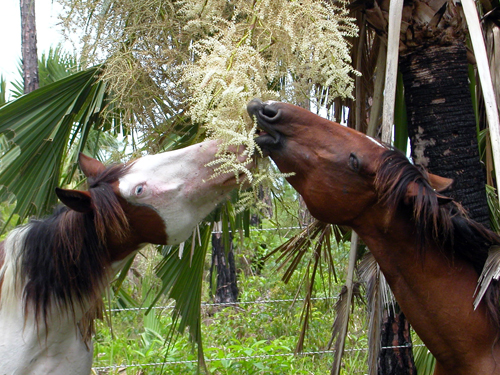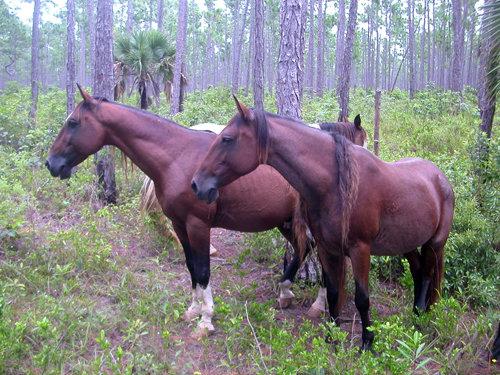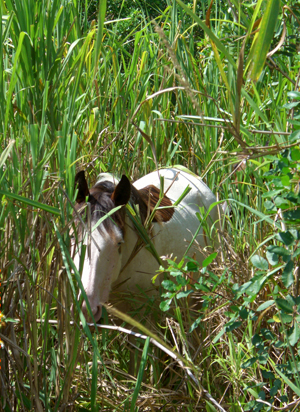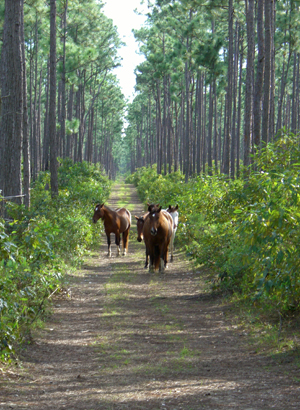
Mare Bellatrix II (left) and Stallion Mimosa enjoy eating the blossoms of a cabbage palm.
|
For years the wild horses of Abaco were thought to be a myth. Animals about whom many stories were told but which were extinct. Actually, the Wild Horses of Abaco are still clinging to a precarious existence on a Preserve in the pine forests of Abaco.
While there are other horses scattered throughout The Bahamas; carriage horses in Nassau, a herd of domestic horses running free on Eleuthera among others, the Abaco Barbs appear to be the only horses in the Bahamas, in fact in the world, with their particular genetic makeup. And dealing with their plight has prevented any work to research the well-being of the other horses. The Bahamas Humane Society has worked to improve the lot of the Nassau carriage horses.
Research for information about the horses' history, both past and recent began in 1992. Based on three separate DNA tests the horses are internationally accepted as a sub group of the rare Spanish Barb breed. They are acknowledged to be critically endangered. and likely are the most rare breed of horse on the planet. Many organizations are hoping to see the horses come back from the brink of extinction for the second time in their recently turbulent history.
Spanish Barbs were bred from the Barbary horses of the North Coast of Africa. One of the desert tribes known as the Moors invaded Spain with these peerless war horses and ruled Spain for hundreds of years. When the Moors were finally driven out of Spain, the Spanish crossed these extraordinary horses with their own impressive breeds and came up with a horse of great intelligence, built for speed, stamina and survival under extreme conditions. The Barb is in no way related to the Arab, having a different bone structure and many characteristics not found in the Arab. It has also been discovered, fairly recently, that one of the founding horses of the Thoroughbred line was a Barb.

Stallion Mimosa, left, and Mare Acamar show classic Barb profiles and conformation.
|
Transported in small, foul stalls with little water and less food on the tossing decks of Spanish ships as they traveled the Caribbean, it is possible that the Abaco Horses arrived when one or more ships wrecked off Green Turtle Cay sometime in the late 1400's or early 1500's. There are many Spanish Wrecks on Green Turtle's reefs.
It is known that horses were brought to Abaco from Cuba in the early 1900's to drag logs out of the forest of Abaco when the forests were clear cut. When tractors came into general use, the horses were abandoned. Yet, it seems odd that stallions and mares would be used to work and not geldings. Until manifests or records can be found in Nassau there is no way to actually check the numbers of horses that arrived. It is also known that Columbus had two horse farms in Cuba. The simple fact is that DNA work shows that the Abaco horses are Spanish, in fact most closely resembling the Puerto Rican Paso Fino. They in no way visually resemble the horses that are now in Cuba for whom no DNA work is available. The point is that no matter how they got to Abaco, these are horses of a known and exceedingly rare type.
The horses, likely half starved and terrified when confronted with the drastic change in their lives, were helped by the steely determination bred into them and managed to adapt to an equine paradise of shady pine forests (or regenerating forests) filled with enough forage and fresh water to help them regain their strength and to stay healthy. The rough ground kept their hooves trimmed. For 500 years they lived in the forests of Abaco, if they came from Spain, and for over 100 years if only Cuban logging horses came here.
Unfortunately, with the building of the Abaco Highway in the 1950's the horses' paradise was destroyed. And the hands of humans have weighed heavily on them ever since. A tragedy involving a blameless wild horse and a child resulted in the slaughter of a herd once estimated to be from 150 to 200 head. Three horses were brought out of captivity and placed on the newly developing Bahama Star farm, located in the middle of a second growth forest. From the one stallion, a mare and her filly the herd rebuilt to about 30 - 35 head when they were roughly counted in 1992. The horses 'commuted' between the farm and the forest.
When hurricane Floyd drove them from the forest to full time on the farm, they once again declined. Several were saved from certain death when roofing nails were removed from their feet after the storm.
Unwilling to move from the over rich grass once planted for cattle, the horses entered a vicious cycle of obesity, which discouraged movement which resulted in laminitis which killed several horses. Unable to move much because of the pain in their hooves, they grew even fatter. Simple intervention with penicillin delivered by blow pipe saved many, but the presence of fertilizers, pesticides and herbicides added to the deadly environment. The horses stopped reproducing. The haven of the farm was a mixed blessing. Inappropriate human actions took several lives.
In 2002 the remaining horses were moved to a government granted preserve of 3800 acres and the horses were back in their ancestral home. Pre existing conditions took more lives. Though the horses limped into the Preserve, from that day forward there has not been one case of lameness other than two incidents of minor bruising which cleared up within days. The long walk to the Preserve started circulation again.
Though they are called wild, meaning free roaming within their area and not 'broken' in any way, wild does not mean streaming manes and tails and pounding hooves. Those means panic. In the bush, as we are privileged to see the horses, they spend nearly all their time foraging and they eat a wide variety of vegetation. They move constantly, keeping their muscles toned, their hooves trimmed. Water holes are plentiful, often rising and falling with the tide of salt water that lies under the fresh water lens trapped in the limestone rocks of Abaco. Gentle hills are the remains of old, petrified sand dunes, for the area was once underwater.

Mare Bellatrix II enjoys grazing in tall cow grass. But the horses have to be kept from too much of this rich food. Unlimited grazing of this type caused obesity and other problems when the horses were on the Bahama Star farm full time.
|
Today the herd is at eight, four mares, four stallions, and even in these small numbers the herd has attracted international attention. They are in glowing good health. They are living time capsules, classic examples of the carefully bred horse with which the Spanish conquered the New World. They are a genetic treasure trove, and WHOA (Wild Horses Of Abaco Preservation Society) in Abaco and Arkwild, Inc. (a 501 c 3 charity) in the US are working hard to keep the herd going.
In 2007 three of the mares appeared to be pregnant, including two with positive sonogram results One mare carried to the point where her she was showing signs of getting ready to give birth, yet, nothing happened. It is assumed the mares reabsorbed. This is a critical, fragile time for the horses and health checks, desperately needed, finally have been scheduled. Also needed is banking of sperm and ova.
It is the goal of Arkwild and WHOA to build the herd back up to viable numbers once again, and to maintain the horses in as free an environment as possible. This offers unique opportunities for research into the behavior of horses free of human dominance. And it allows visitors a chance to experience a peaceful, hushed environment and to meet with some of nature's most rare and beautiful creatures on the horses' own terms.
For more information, you can visit
www.arkwild.org
or call 242-367-4805 for more information. As with all charitable efforts, funds are need to improve the infrastructure of the preserve, to help maintain fire breaks and keep the fence lines clear, for long overdue medical support. All funds go directly to Arkwild (donations are tax deductible for US citizens) or to WHOA for direct benefit of the horses.

Four of the eight Abaco Barb horses on the main logging road through the Preserve
|
